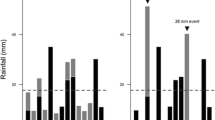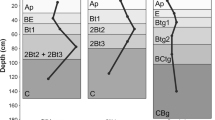Abstract
The objectives of this study were to (1) evaluate earthworm-induced leaching of water and salt from salt-affected agricultural soils with constant and fluctuating soil moisture conditions and (2) determine the effects of earthworms on the distribution of soil salt in casts, burrow walls, and surrounding soils responsible for salt leaching. Soils were kept in mesocosms at constant moisture (CM) or underwent one wet–dry process (WD). Each soil moisture treatment had three earthworm treatments, including (1) inoculation with high abundance of earthworms (five endogeic Aporrectodea trapezoides), (2) inoculation with moderate abundance of earthworms (three endogeic A. trapezoides), and (3) no earthworm treatment. The presence of earthworms significantly increased total leaching water volume compared to the same treatment without earthworms in both moisture treatments. In the treatment following the wet–dry process, more than 65 % of water leaching occurred during the rainfall event, whereas in the treatment following constant moisture, more than 60 % of water leaching occurred after the rainfall event. The presence of earthworms produced a higher salt amount in the leaching water than the same moisture treatment without earthworms, but only the low number of earthworms (three endogeic A. trapezoides) caused a significantly higher total amount of leached salt than the same moisture treatment without earthworms. The percentage of leached salt in leaching water during the rainfall event ranged from 75.31 to 79.93 % in the wet–dry treatment and from 41.28 to 50.65 % in the constant moisture treatment. The wet–dry process significantly increased the total amount of leached salt from salt-affected agricultural soil compared to the constant moisture treatment when earthworms were present, which may be due to the significantly higher electrical conductivity of saturation extract (ECe) of earthworm casts than those of burrow walls and surrounding soils in the 0- to 10-cm soil layer.

Similar content being viewed by others
References
Amossé J, Bettarel Y, Bouvier C, Bouvier T, Duc TT, Thu TD, Jouquet P (2013) The flows of nitrogen, bacterial and viruses from the soil to water compartments are influenced by earthworm activity and organic fertilization (compost vs. vermicompost). Soil Biol Biochem 66:197–203
Babiker IS, Mohamed MA, Terao H, Kato K, Ohta K (2004) Assessment of groundwater contamination by nitrate leaching from intensive vegetable cultivation using geographical information system. Environ Int 29:1009–1017
Bardgett RD, Anderson JM, Behan-Pelletier V, Brussaard L, Coleman DC, Ettema C, Moldenke A, Schimel JP, Wall DH (2001) The influence of soil biodiversity on hydrological pathways and the transfer of materials between terrestrial and aquatic ecosystems. Ecosystems 4:421–429
Bastardie F, Capowiez Y, Cluzeau D (2005a) 3D characterisation of earthworm burrow systems from natural soil cores collected on a 12 year old pasture. Appl Soil Ecol 24:3–16
Bastardie F, Ruy S, Cluzeau D (2005b) Assessment of earthworm contribution to soil hydrology: a laboratory method to measure water diffusion through burrow walls. Biol Fert Soils 41:124–128
Bodner G, Scholl P, Kaul HP (2013a) Field quantification of wetting-drying cycles to predict temporal changes of soil pore size distribution. Soil Till Res 133:1–9
Bodner G, Scholl P, Loiskandl W, Kaul HP (2013b) Environmental and management influences on temporal variability of near saturated soil hydraulic properties. Geoderma 204:120–129
Bottinelli N, Hallaire V, Menasseri-Aubry S, Le Guillou C, Cluzeau D (2010) Abundance and stability of belowground earthworm casts influenced by tillage intensity and depth. Soil Till Res 106:263–267
Capowiez Y, Monestiez P, Belzunces L (2001) Burrow systems made by Aporrectodea nocturna and Allolobophora chlorotica in artificial cores: morpho-logical differences and effects of interspecific interactions. Appl Soil Ecol 16:109–120
Capowiez Y, Sammarino S, Michel E (2014) Burrow systems of endogeic earthworms: effects of earthworm abundance and consequences for soil water infiltration. Pedobiologia 57:303–309
Chaudhuri PS, Pal TK, Nath S, Dey SK (2012) Effects of five earthworm species on some physico-chemical properties of soil. J Environ Biol 33:713–716
Dittbrenner N, Moser I, Triebskorn R, Capowiez Y (2011) Assessment of short and long-term effects of imidacloprid on the burrowing behaviour of two earthworm species (Aporrectodea caliginosa and Lumbricus terrestris) by using 2D and 3D post-exposure techniques. Chemosphere 84:1349–1355
Domínguez J, Bohlen PJ, Parmelee RW (2004) Earthworms increase nitrogen leaching to greater soil depths in row crop agroecosystems. Ecosystems 7:672–685
Duarte AP, Melo VF, Brown GG, Pauletti V (2014) Earthworm (Pontoscolex corethrurus) survival and impacts on properties of soils from a lead mining site in Southern Brazil. Biol Fert Soils 50:851–860
Ernst G, Felten D, Vohland F, Emmerling C (2009) Impact of ecologically different earthworm species on soil water characteristics. Eur J Soil Biol 45:207–213
Görres JH, Savin MC, Amador JA (2001) Soil micropore structure and carbon mineraliztion in burrows and casts of an anecic earthworm (Lumbricus terrestris). Soil Biol Biochem 33:1881–1887
He Y, DeSutter T, Hopkins D, Jia X, Wysocki DA (2013) Predicting ECe of the saturated paste extract from value of EC1:5. Can J Soil Sci 93:585–594
Jégou D, Cluzeau D, Wolf HJ, Gandon Y, Tréhen P (1998) Assessment of the burrow system of Lumbricus terrestris, Aporrectodea giardi, and Aporrectodea caliginosa using X-ray computed tomography. Biol Fert Soils 26:116–121
Joschko M, Gebbers R, Barkusky D, Timmer J (2010) The apparent electrical conductivity as a surrogate variable for predicting earthworm abundances in tilled soils. J Plant Nutr 173:584–590
Lachnicht SL, Parmelee RW, McCartney D, Allen M (1997) Characteristics of macroporosity in a reduced tillage agroecosystem with manipulated earthworm populations: implications for infiltration and nutrient transport. Soil Biol Biochem 29:493–498
Lado M, Paz A, Ben-Hur M (2004) Organic matter and aggregate-size interactions in saturated hydraulic conductivity. Soil Sci Soc Am J 68:234–242
Lamandé M, Hallaire V, Curmi P, Pérès G, Cluzeau D (2003) Changes of pore morphology, infiltration and earthworm community in a loamy soil under different agricultural managements. Catena 54:637–649
Larink O, Werner D, Langmaack M, Schrader S (2001) Regeneration of compacted soil aggregates by earthworm activity. Biol Fert Soils 33:395–401
Lavelle P, Bignell D, Lepage M (1997) Soil function in a changing world: the role of invertebrate ecosystem engineers. Eur J Soil Biol 33:159–193
Marashi ARA, Scullion J (2003) Earthworm casts form stable aggregates in physically degraded soils. Biol Fert Soils 37:375–380
Mariani L, Jiménez JJ, Asakawa N, Thomas RJ, Decaëns T (2007) What happens to earthworm casts in the soil? A field study of carbon and nitrogen dynamics in Neotropical savannahs. Soil Biol Biochem 39:757–767
Mavi MS, Marschner P (2012) Drying and wetting in saline and saline-sodic soils-effects on microbial activity, biomass and dissolved organic carbon. Plant Soil 355:51–62
Metternicht GI, Zinck JA (2003) Remote sensing of soil salinity: potentials and constraints. Remote Sens Environ 85:1–20
Michel E, Majdalani S, Di Pietro L (2010) How differential capillary stresses promote particle mobilization in macroporous soils: a novel conceptual model. Vadose Zone J 9:307–316
Mubarak I, Mailhol JC, Angulo-Jaramillo R, Ruelle P, Boivin P, Khaledian M (2009) Temporal variability in soil hydraulic properties under drip irrigation. Geoderma 150:158–165
Paranychianakisa NV, Chartzoulakis KS (2005) Irrigation of Mediterranean crops with saline water: from physiology to management practices. Agr Ecosyst Environ 106:171–187
Parkin TB, Berry EC (1999) Microbial nitrogen transformations in earthworm burrows. Soil Biol Biochem 31:1765–1771
Pimentel D, Berger B, Filiberto D, Newton M, Wolfe B, Karabinakis E, Clark S, Poon E, Abbett E, Nandagopal S (2004) Water resources: agricultural and environmental issues. Bioscience 54:909–918
Pires LF, Bacchi OOS, Reichardt K (2005) Gamma ray computed tomography to evaluate wetting/drying soil structure changes. Nucl Instrum Meth B 229:443–456
Pires LF, Bacchi OOS, Reichardt K (2007) Assessment of soil structure repair due to wetting and drying cycles through 2D tomographic image analysis. Soil Till Res 94:537–545
Qadir M, Schubert S (2002) Degradation processes and nutrient constraints in sodic soils. Land Degrad Dev 13:275–294
Rietz DN, Haynes RJ (2003) Effects of irrigation-induced salinity and sodicity on soil microbial activity. Soil Biol Biochem 35:845–854
Schrader S, Zhang HQ (1997) Earthworm casting:stabilization or destabilization of soil structure? Soil Biol Biochem 29:3–4
Seguel O, Horn R (2006) Structure properties and pore dynamics in aggregate beds due to wetting and drying cycles. J Plant Nutr Soil Sci 169:221–232
Shipitalo MJ, Butt KR (1999) Occupancy and geometrical properties of Lumbricus terrestris L. burrows affecting infiltration. Pedobiologia 43:782–794
Shipitalo MJ, Le Bayon RC (2004) Quantifying the effects of earthworms on soil aggregation and porosity. In: Edwards CA (ed) Earthworm ecology. CRC Press, Boca Raton, FL, pp 183–200
Shipitalo MJ, Protz R (1988) Factors influencing the dispersibility of clay in worm casts. Soil Sci Soc Am J 52:764–769
Shuster WD, Subler S, McCoy EL (2002) The influence of earthworm community structure on the distribution and movement of solutes in a chisel-tilled soil. Appl Soil Ecol 21:159–167
Tao J, Gu W, Griffiths BS, Liu XJ, Xu YJ, Zhang H (2012) Maize residue application reduces negative effects of soil salinity on the growth and reproduction of the earthworm Aporrectodea trapezoides, in a soil mesocosm experiment. Soil Biol Biochem 49:46–51
Tao Y, Gu W, Chen J, Tao J, Xu YJ, Zhang H (2013) The influence of land use practices on earthworm communities in saline agriculture soils of the west coast region of China’s Bohai Bay. Plant Soil Environ 59:8–13
Tripathy S, Rao KS, Fredlund DG (2002) Water content-void ratio swell-shrink paths of compacted expansive soils. Can Geotech J 39:938–959
Trojan MD, Linden DR (1992) Microrelief and rainfall effects on water and solute movement in earthworm burrows. Soil Sci Soc Am J 56:727–733
Wang X, Hu F, Li HX (2005) Contribution of earthworm activity to the infiltration of nitrogen in a wheat agroecosystem. Biol Fert Soils 41:284–287
Wichern J, Wichern F, Joergensen RG (2006) Impact of salinity on soil microbial communities and the decomposition of maize in acidic soils. Geoderma 137:100–108
Willoughby GL, Kladivko EJ (2002) Water infiltration rates following reintroduction of Lumbricus terrestris into no-till fields. J Soil Water Conserv 57:82–88
Yan N, Marschner P (2012) Response of microbial activity and biomass to increasing salinity depends on the final salinity, not the original salinity. Soil Biol Biochem 53:50–55
Yuan BC, Li ZZ, Liu H, Gao M, Zhang YY (2007) Microbial biomass and activity in salt affected soils under and conditions. Appl Soil Ecol 35:319–328
Acknowledgments
We would like to thank the staff of the Huanghua Experimental Farm who helped with the collection of earthworms and soil. This research was supported by the National Natural Science Foundation of China (41201237) and the Free Exploring Foundation from the State Key Laboratory of Earth Surface Processes and Resource Ecology (2012-ZY-04).
Author information
Authors and Affiliations
Corresponding author
Rights and permissions
About this article
Cite this article
Wang, Y., Chen, J., Gu, W. et al. Earthworm activities increase the leaching of salt and water from salt-affected agricultural soil during the wet–dry process under simulated rainfall conditions. Biol Fertil Soils 52, 323–330 (2016). https://doi.org/10.1007/s00374-015-1078-0
Received:
Revised:
Accepted:
Published:
Issue Date:
DOI: https://doi.org/10.1007/s00374-015-1078-0




